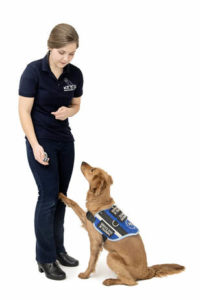Are you thinking of training a DAD but don’t know what you would like as an alert? Below are common alert behaviors as well as the benefits and difficulties of them.
 Paw – this is by far the most common alert behavior. It is easy to teach and the dogs can do it from any age. Another benefit of pawing as an alert is it is discreet and can be done when the dog is still laying down, minimizing the disruption to those around you. The difficulties are if you have a large dog or enthusiastic alerter, the pawing can be slightly painful. Their nails have to be kept very short to prevent scratches on your leg. If the dog will be alerting directly to a child then the pawing may be uncomfortable as well.
Paw – this is by far the most common alert behavior. It is easy to teach and the dogs can do it from any age. Another benefit of pawing as an alert is it is discreet and can be done when the dog is still laying down, minimizing the disruption to those around you. The difficulties are if you have a large dog or enthusiastic alerter, the pawing can be slightly painful. Their nails have to be kept very short to prevent scratches on your leg. If the dog will be alerting directly to a child then the pawing may be uncomfortable as well.
Nudge – this is an increasingly popular alert, the dog nudges your hand or pokes your leg. Nudging your hand can be difficult if your hand is not easily reached at the moment (typing at a computer, walking, etc.). A nudging at the leg is a better choice and is typically effective. But it is sometimes difficult to differentiate between a nudge for general attention and a nudge as an alert.
 Bringsel – a bringsel is a stuffed cylinder or a tab that the dog holds in their mouth. It can be velcroed onto someone’s beltloop or it can hang on the dog’s collar, depending on the need. The benefit to a bringsel is it is extremely distinct – the dog only holds it when it is alerting and it very clearly shows the need to test your blood sugar. If the bringsel hangs on your beltloop, you will always know when the dog is alerting because it is coming to you and pulling it off, but not all clothing has beltloops which can cause confusion for the dog if the bringsel is not available. I have had more success with hanging the bringsel on the dog’s collar using a carabiner or using a training tab that clips onto the dog’s collar. Bringsels require more training and the behavior is less natural for the dog, but that is also why it is an extremely clear alert.
Bringsel – a bringsel is a stuffed cylinder or a tab that the dog holds in their mouth. It can be velcroed onto someone’s beltloop or it can hang on the dog’s collar, depending on the need. The benefit to a bringsel is it is extremely distinct – the dog only holds it when it is alerting and it very clearly shows the need to test your blood sugar. If the bringsel hangs on your beltloop, you will always know when the dog is alerting because it is coming to you and pulling it off, but not all clothing has beltloops which can cause confusion for the dog if the bringsel is not available. I have had more success with hanging the bringsel on the dog’s collar using a carabiner or using a training tab that clips onto the dog’s collar. Bringsels require more training and the behavior is less natural for the dog, but that is also why it is an extremely clear alert.
Doorbell – dog doorbells are available and can be used as alerts. These are not practical for all alerts but are excellent for night alerts or when the dog is in a kennel or confined area. Ringing a doorbell is usually an easy task for the dog to learn if it already alerts using a paw or a nudge.
Bark – a bark alert is easy to notice but is not a good alert for a Diabetic Alert Dog because the dog will become a disruption in public. Additionally, if the dog is taught to bark it will likely bark for other reasons as well which can make it difficult to differentiate between barking for an alert and barking for other reasons.
Bow – a play bow is a stress signal and is sometimes a natural behavior for a dog when alerting. (Stress signals are not always bad, they often just show that the dog is thinking.) A bow as an alert can be an easily taught alert behavior, based on the individual dog. One difficulty is the dog does have to stand up in order to perform the behavior which can be a slight disruption in public if in a meeting or classroom setting. It is still an acceptable alerting behavior (unlike the level of disruption that barking causes), but the disruption is something to keep in mind when choosing an alerting behavior.
Spin – spin is just a trick that can be taught as an alert. It is not a natural stress signal like the bow so it may take a little while longer for the dog to learn it but it is possible and is not difficult. However, spin requires a lot of space and the dog getting up and walking in a circle can be slightly disruptive to those around you when in public. Additionally, when the dog is slightly tired it may be difficult to determine the difference between the dog walking in a circle and the dog alerting.
I recommend either just a paw alert, or a combination of the bringsel alert (with the bringsel on the collar) and a paw alert for most situations. The paw-bringsel combination is more difficult to teach, but ensures that the dog makes physical contact with the handler and gives a very clear alert that is not painful. When the dog is in a kennel or during the night I recommend a doorbell alert. The MD Dogs methods teach the paw as the alert behavior.